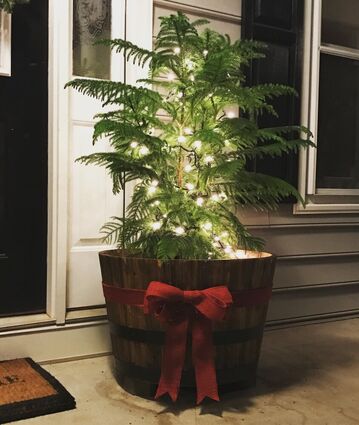Norfolk Island Pine: A Living Christmas Tree
Last updated 12/6/2022 at 6:23pm

Norfolk Island Pine tree simply adorned and lighted by a homes entryway (image courtest Pintrest.com)
The needled branches of Norfolk Island Pine trees (Araucaria heterophylla), look right at home during the holidays! They can be decorated as Christmas trees and once the holidays become pleasant memories, remove the decorations, and enjoy their classic look anywhere you have bright light in your home. Norfolk Island Pine trees are not deciduous, maintaining needles year-round, unless the trees become stressed. They are evergreen conifers and despite their resemblance, not "true" pine trees. The trees are tropical, with their native habitat originating in the South Pacific Islands of New Zealand, Australia, and New Caledonia.
Grown indoors, the tree is slow growing but over the course of a few years can easily grow to 8 or 10 feet. While small, the tree makes a wonderful accent to a kitchen counter, Livingroom end table, or mantle. As the tree grows larger, it is better situated as a floor plant used as a stand-alone focal point, to fill bright corners or flank large furniture. If faster growth is the goal, move the Norfolk Island Pine tree outdoors to a protected site which is shaded, or an area which only receives morning sunlight. Since the tree is tropical, wait until all danger of frost has passed before relocating the tree outdoors and make certain to return it indoors before our initial frost.
The Norfolk Island Pine tree enjoys growing in our homes when it receives medium to bright light. One of the most important things to remember is the plants light requirement-the less light it receives, the slower the tree will grow. Avoid low light situations since the tree will not perform well if it doesn't receive enough light, becoming flimsy, unsightly, and lanky.
The watering requirements for Norfolk Island Pine trees are straight forward, they like evenly moist soil but do not like "wet feet" where the roots are standing in water. The tree's roots will rot quickly if they remain standing in water. If the plant remains dry for long periods, the tips of its branches will die, turning brown. Fertilize the tree twice annually- once during the spring and again during the summer months, or more often if you prefer faster growth. Norfolk Island pines are low maintenance plants for the most part but do require some care. Use the following tips to maintain a beautiful tree almost effortlessly, year after year!
Tips for Growing Norfolk Island Pine Trees
• Growing Medium- if the tree was purchased during the holidays, remove the festive colored wrap once the holidays have passed, they retain too much water, and the tree will suffer from root rot. Repot the plant with a good quality, peat based potting soil mix adding perlite, sand, pebbles, or bark for increased drainage. Choose a new pot with substantial drainage holes at the bottom of the pot to ensure adequate drainage.
• Light Requirement- for the Norfolk Island Pine tree to flourish indoors, make certain they receive enough light. Direct sunlight can severely damage the tree. Place the tree near a south-facing window as bright, indirect light is best. Mist the tree daily, if you can remember too or consider purchasing an inexpensive humidifier for gardeners like me, who tend to forget this step.
• Root Care- Norfolk Island pines are highly susceptible to root rot. If the needles begin to brown or the tree limbs wilt, immediately look at the tree's roots as this is preventable with the correct soil mix. If root rot is noticed, remove the clumpy, rotten roots and rinse thoroughly with clean water and repot the remainder of the root system in a soil mixture which provides increased drainage.
• Fertilizer Application- fertilizing these pines infrequently, unless faster growth is wanted. Provide them with the extra boost of fertilization half as often as you would with other plants. Keep in mind your young Norfolk Island pines want to grow-and grow very tall, for that matter. While these tropical plants are slow growers, if the tree begins reaching heights beyond what is manageable to you, consider pruning it.
• Pruning- the pruning process is simple and consists of cutting the tree down to a desirable height, discarding the top portion, and allowing it to grow again from that point. Consider trimming the upper branches at this point and leaving the lower branches intact for a more natural look.
• Pests- Norfolk Island Pine trees are susceptible to the same insect assailants as any other house or garden plants. Utilize insecticidal soaps or pesticides as necessary depending on pest infestation: aphids, mealybugs, etc. and following insecticide use guidelines.
• Propagation- propagation of the tree is possible through planting of seeds or cuttings. Seeds should be purchased rather than from the tree itself. Cuttings must be taken from the tree's trunk (center)-as limb cuttings will not propagate.
So long for now fellow gardeners! Let's go out and grow ourselves a greener, more sustainable world, one plant at a time!
If you have specific gardening questions or would like more information, send me an email: [email protected] or contact the Orange County Master Gardeners Helpline: (409) 882-7010 or visit our website: https://txmg.org/orange, Facebook: Orange County Texas Master Gardeners Association or Email: [email protected].













Reader Comments(0)